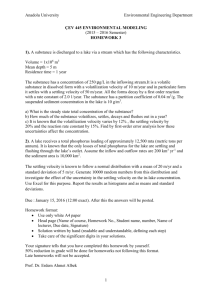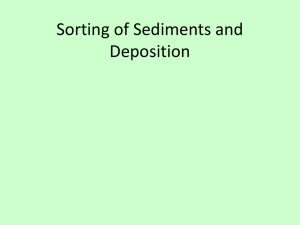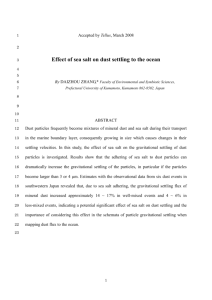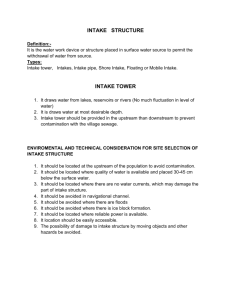Settling Property Determination
advertisement
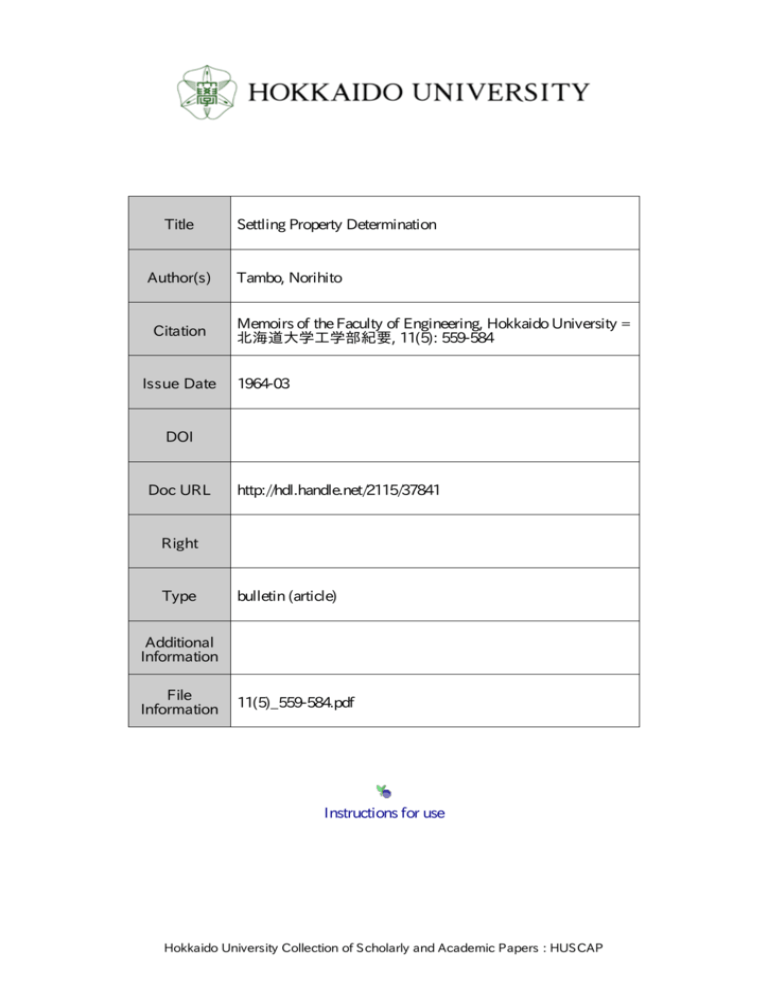
Title
Author(s)
Citation
Issue Date
Settling Property Determination
Tambo, Norihito
Memoirs of the Faculty of Engineering, Hokkaido University =
北海道大学工学部紀要, 11(5): 559-584
1964-03
DOI
Doc URL
http://hdl.handle.net/2115/37841
Right
Type
bulletin (article)
Additional
Information
File
Information
11(5)_559-584.pdf
Instructions for use
Hokkaido University Collection of Scholarly and Academic Papers : HUSCAP
Settling Property Determination
Norihito TAMBO
Abstract
In this paper the author proposed to use time-accumulation curves as
a fundamental property to define the settling property of a suspension. Two
methods to determine time-accumulation-curves were devised. One is the
baiance analysis method for laboratory use and the other is the pipette analysis
method for field practice.
L Settling Velocity of Discrete Particles
The settling properties of various suspensions, flocculated and otherwise,
are the most important factors in the design and operation of the sedimentation
processes. As is well known, the settling phenomena are classified into three
categories; free settling, hindered settling and compression. In addition, free
settling is divided into two categories, non-flocculent and flocculent settling.
The former is the settllng of discrete partlcles without interaction with other
particles. This phenomenon is to be considered as the fundamental one.
Other states of sedimentation are considered on the basic theory of discrete
particle settling.
The classic laws of sedimentation of individual particles were developed
by Stokesi), Allen2), Newton3), Tsurumi`) and others5). Under the influence of
gravity, any particle having a greater density than that of water will settle in
water at an accelerating velocity untii the frictional drag of the water against
the particle reaches the driving force, namely the effective weight of the particle. After the initial transient situation, the settling velocity is essentially
constant and depends upon the size, shape and density of the particle, and
the density and viscosity of the water. For theoretical computation of settling
velocity, the particle is commonly assumed to be spherical. Settling velocities
of other shaped particles can be analyzed in relation to spheres.
The general equation for the settling velocity of an indivldual particle is
shown as follows:
wn .,= mflm.
3
where
w= the
g
(to - P,)
k
p gi-i
ptn-2d3-m
settling velocity of discrete particles (cmlsec)
(1)
Norihito TAMBO
560
n==: the state of fiow; i.e., n=:1 for stream line fiow, n is more
than 1 but less than 2 for transitional flow, and n=2 for
turbulent flow.
g = the accelerdiion of gravity (cm!sec2)
P =:= the density of the particle (gfcm3)
Po := the density of the liquid (g!cm3)
pt = the viscosity of the liquid (glcm・sec)
d:= the diameter of the particle (cm)
k == a constant having the following relationship with the coefllcient
of drag CD;
C. =- k( wdP Yt-2
== kRn--2
(2)
pt /
R == the Reynolds
number
Stokes' Law
When the particle diameter d is sufficiently smail, the predominance of
viscous forces results in accelerative and resistive forces proportionai to the
first power of the velocity, i.e. m==1 in Equation (1) and the drag coefllcient
CD is given as follows;
c.=-k-=
24 or 24 (3)
dev
RR
Then the Equation (1) becomes;
l8
.= 1g (P-Po) d2. (4)
ptPo
Figure (1) shows that it fits experimental data exactly for values of R up
to about O.55, and offers a reasonably good fit, up to R=1.0.
Newton's Law
When the inertia force become so predominant that the resistive force is
proportional to the second power of the velocity (n=2) then CD=k・ The
experimental data in Figure 1 show that CD=:O・4・
Substituting n==2 and k=O.4 in Equation (1);
w-1.82V(P7,Po) dtr. (5)
CD=k==O.4 fits the experimentai data in the R range of 1.000-250,OOO.
A!len's Law
・ If the values CD==301RO'625 and n=1.375 are substituted in Equation (1)
Settling Property Determination
561
then the resulting equation,
w=-o2o[(P 7,Po) g]O '2 [( p.d,')i,8 ,,] (6)
gives a reasonable degree of fit to the experimental data for ail values of R
from 1 to 1,OOO. This is called Allen's law.
Figure 26> shows the commonly accepted value for sand particles of
specific gravity of approximately 2.65 and for flocs having a specific gravity
of approximately 1.001 to 1.50. According to the curves shown in Figure
2, almost all coagulated particles are in the range of Stokes' and Allen's
iaws. It is possible to apply Stockes' law to rather minute particles; when
the density of fioc is 1.02 and water temperature is 100C, the applicable upper
limit of Stokes' law is to a floc having a diameter of O.6mm. Therefore, it
is necessary to use Allen's iaw for the well flocculated particles in the calculation of settiing velocity.
II. Principle of Settling Property Measurement
for Discrete Particles')
As stated in the previous section, each discrete particle would settle
according to any one of the laws stated before. However, in a practical case,
in a settling basin, there are many sized particies ranging from Stokes' range
to Newton's range in a suspension. For the purpose of a sedimentation basin
design, it becomes essential to know and identify the settling property of the
suspension. To describe the settling property of a suspension of particles, it
is convenient to use sett}ing velocity distribution. This can be found by suitable experimental measurements of a suspension and is independent of the type
of governing sedimentation law for each component particle of the suspension.
It is furthermore directly useful for sedimentation basin design.
Possible methods of measuring settling velocity incfude optical and electron
microscopy, radiation scattering and transmission, light scattering and transmis-
sion, and sedimentation. Among these, the method of sedimentation is by its
nature the most direct way to measure the settling velocity distribution. It is
also the simplest. All of the other methods are indirect and a suitable sedi-
mentation law must be assumed in the calculation of the settling velocity
distribution from the measurements.
Gravitational sedimentation methods for rneasuring the settling veiocity
distribution can be divided into two categories, the 'incremental method and
the cumulative method. In the first, concentrations are measured at a fixed
562 Norihito TAMBo
point below the surface of the fluid at various times or at different points at
an instant of time after settling begins. In the second, or cumulative method,
the accumulated sediment is measured at a fixed levei until a}1 particles between
that point and the fluid's surface have settled.
Among incremental methods, the pipette method and the density method
-the hydrometer method-are most common. However, for the purpose of
plane sedimentation basin design in water works either method is not suthcient.
The former requires a great many samples to make possible a high accuracy
of measurement for such Iow concentration suspensions as may occur in raw
water of ordinary water works. In addition, it is troublesome to evaporate the
water from the sample for weighing. The latter hydrometer method does not
have ample sensltivity for these dilute suspensions.
On the other hand, should the use of a sensitive automatic weighing
instrum'ent be available, the cumulative method would be the most convenient
method for these purposes. The author suggests the use of cumulative weight
method using a sensitive autobalance for the settling analysis of discrete
particles.
In the cumuiative weight method, the settling velocity distribution function
of a suspension is obtained by weighihg the particles as they accumulate on
a pan at the bottom of the settling analysis cylinder. It will be assumed that
the pan has unit area and is situated at a depth h from the surface of the
suspension. The fluid through which the particles move is considered quiescent. At the initial state the particles of each size are distributed uniforrhly
throughout the settling tube. The settling of each particle is assumed indepen-
dent of the others, i.e. no hindered settling is assumed. After time t some
particles suspended between the surface and the depth h at the initial stage
pass through the horizontal plane at the depth h and others remain in the
water body above depth h. Those particles which pass through the h plane
are intercepted by the pan. The pan receives all of the particles falling down
from the column having unit cross-sectional area and height h above the pan.
No consolidation occurs for the particles which accumulate on the pan; then
no variation of the apparent density occurs in the course of measurement of
accumulation weight.
As shown in Figure 3 the accumulated weight G increases with time t
and finally reaches an asymptote which is paraliel to the horizontal axis of
the graph. The height of the asymptote above the horizontal axis is the ultirnate accumulation weight of the suspension.
The function f(2u) is called the frequency distribution function of particle
settling ve}ocity of a suspension, or simply in this thesis, the frequency distri-
Settling Property Determination 563
bution function. The quantity f(zev)dw means the weight of particles with
a settling velocity between zv and w+dzu as shown in Figure 4. For discrete
particles f(zv) is a fixed property of suspension.
The weight g(t) of particles which settled in time t on the pan at the
depth h is made up of two parts, the particles having greater settling velocity
than zvi and those having a smaller velocity:
q(t) =Sjl,M. "Xf(ZV)dW+Si".f.,. ZXtf(ZU)CftV (7)
where
q(e: the weight of particles settling at time t upon an accumulation
pan at depth h.
xv: the settling velocity of a particle
w...: the settling velocity of the largest suspended particle
zv.i.: the settling velocity of the smallest suspended particle
zv,: the settling velocity of the particle which falls the distance h in
time t; i.e., w: :=h!t
Differentiating Equation (7) with respect to t gives;
dedt(t) = -f(ZU`) d,Wlti + ZVhZ,'t f(TUa) drdVti +Si,lk,,. Zof(ZhU)drV
== SI."e.' ,. Wfh(ZV) thev' (8)
Let 2(w) denote the total weight of particle having a settling velocity
greater than zv. Then, from Equation (7) and (8), it can be seen that
q(t) -2(-II-) .+tdedt(') (9 a)
and letting w=h/t gives
2(zv) :- q(t)-t. dodt(t) (9 b)
f(w)- - d9.(.W) - - d2,`,W) ・ £`.
-E{l,[ded,(`)-ded,(`)-t・-dd2q,(,t)]==:-i-gZdl2g,(,t) (lo)
where q(t): the cumulative frequency distribution of particle settling velocity.
Therefore, with the use of a suitable balance, it is possible to determine
the settling velocity distribution as a function of the cumulative function q(t).
Norihito TAMBO
564
But commonly the function g(D is not known strictly, so that it is necessary
to perform stepwise numerical differentiation using the accumulation curve
which is given at n points at equal intervals t as shown in Figure 4.
Equation (9b) may be modified as follows for the purpose of stepwise
calculation.
2,-,-G,-iat・ Gi-Gz-i -= (1-i)q+G.",. al)
dt
As shown in Figure 4 the ordinate of the frequency distribution diagram
is divided Jnto n sections of wldth tizv between w.i. and zvm.x・
ATv= Wmax-Wmin (12)
7Z
The weight of particles belonging to each increment is calculated according
to the following equations:
I;i=Gn-[(1-n)Gn+nGn-i]=n(GnunGn-i)
f7;,-,==:G,,-[(2-n)G.-,+(n-1)G,,",]-I},
]F;,-2==:G.-[(3mn)Gn-i+(n-2)G,,-i]-(E,+Et-i) (13)
id 1
Iil, - G,,-[(1-i)G,+iG,-,]-.Z. ].=,,Iil,
o
-EL = GnHX ]Ei
i=-71
where 17L==theweightoftheparticleshavingthesettlingvelocity
IJVL :== hll12・(4 + 4-,)・
It is possib}e to determine the frequency distribution of the settling velocity
by a graphical method based on the same idea.
III. Settling Property Measurement of
Flocculent Particles8)
When two or more suspended particles collide, join and behave as a single
particle thereafter, the phenomenon is called floccuiation. Suspensions in which
the particles have a tendency to fiocculate are called flocculent suspension, and
the particles are called flocculent particles.
The particles caused by chemical coagulation, such as alum floc, are typical
of the phenomenon. The discussion in the previous section does not apply
directly to the description of the settiing of flocculent particles such as alum
fiocs. The flocs are put into the settling cylinder and dispersed uniformly
Settling Property Determination 565
throughout the whole depth of the cylinder at the beginning of the analysis.
Then settling begins. In the course of settling, because of the non-uniformity
of the particle size in the suspension, the greater particles, having a higher
settling velocity, collide and capture the smaller particles of slower velocity.
Thus the frequency distribution of the settling velocity and the total number
of the particles in the suspension changes momentarily. Then for the flocculent suspensions it is necessary to devise a new method for describing the
settling properties to xeplace the steady frequency {or discrete suspensions.
The quantity of paricles which accumulate on a unit horizontal area at
depth h below the surface of suspension in the short period dt can be given
as follows:
cl9 ==: [SiV,::..X zv・f(Tv, h, t) ciner]clt (14)
where zv:thesettlingvelocityofaparticle
f: the instantaneous frequency distrlbution function of particle settling velocity. That is, f(w, h, edev is the weight of particles
per unit volume at depth h, at time t, with the velocity in the
range zv to w+drv
Tu...: the Iargest settling velocity which can be seen in the suspension
w.i.: the smallest settling velocity which can be seen in the suspension
In actual cases it is impossible to measure f(Tv, h, t). By the introduction
of the idea of instantaneous mean settling velocity z-ei defined by the Equation
(15), we have
S:".:l.X w ・f(zv, h, t) dw
z-w =
Si",r.:,.Xf(w, h, t) dw .
(15)
Equation (14) can be rewritten as follows:
dq == [lev(h, t)Si.":l.i f(W) h, t) `inU]dt
-: z-ev (h, t)・C(h, t) dt (16)
where z-v(h, t): the instantaneous mean settling velocity of whole particles at
time t and depth h
C(h, t): the total weight of whole particles in a unit volume at time t
and depth h. This is called instantaneous local concentration
of particles
Typical accumulation curves of flocculent and non-flocculent suspensions
566 Norihito TAMBo
are shown in Figure 5. The accumulation curves of non-flocculent suspensions
have no transition point, but those of flocculent suspensions are generally
S-shaped as in curve 2. The manifestation of such a transition point in
accumulation curves for fiocculent suspensions can be exp]ained schematically
by Figure 6.
For simplicity, consider a suspension which consists of particles of two
sizes. The initial settling property of each particle can be seen by the accumu-
lation curve O-C, for smal}er particles and the curve O-Bi for larger
particles. Assume that at time A, flocculation happens instantly at every point
of the cylinder. Actually the phenomenon occurs continuously in the whole
volume of the settling tube. Now some of the larger particles of Group II
will collide with some of the smaller particles of Group I. Group I then loses
weight AC, but the settling velocity of the remaining smaller particles remains
the same. Hence, the initial accumulation curve O-C, is deformed into
OAiCi. On the other hand Group II increases its total weight from Bo-Bi
to Bo-BE, gaining group weight dC, and increases in mean settling velocity.
The increase in settling velocity of Group I decreases the total settling period
necessary for this group from B, to (B,-dt). Hence, curve OB, should be
corrected to OA,B2. Then, by the addition of both component curves, the
accumulation curve of the whole suspension is shown as OABC. It indicates
the typical S-shaped curve which differentiates prominently flocculant suspensions from non-flocculent suspensions.
As the preceding discussion indicates the settling phenomena of flocculent
suspensions are too complex to be treated by theoretical means and even by
complete statistical treatment of experimental data, so that it is necessary
to devise other convenient and practical methods of describing the settling
propertles.
For practical purposes, time accumulation curves are often compared in
terms of the items (i) t(25%), t(50%), t(75%), t(95%) and so on, and
(ii) t(trans.) which are defined as follows:
(i) Each index t(25%), t(50%), t(75%) and t(95%) means the time
required from the beginning of the settling to the settling of 25%, 50%, 75%
and 95% respectively of the suspended particles on the accumulation pan, and
(ii) t(trans.) is the time when the time-accumulation curve q(a has its transition
point. It also shows the time when the maximum value of dg(t)!at occurs.
It is possible to determine the point of the maximum sludge deposition in an
ideal basin in accordance with following relations:
X(S-max)-t(trans.) >< Uh (17)
SettlingtProperty Determination 567
where X(Smax): the distance from the inlet of, the ideal settling basin to the
point where maximum depth of the settled sludge can be
seen. i,
U6: the mean displacement velocity of the ideal basin.
Curves of vumu(h, t) are also useful in studying settling properties of floccu-
lent suspensions. Such curves can be determined experimentallY by the follow-
ing method. The concentration c(t, h) adjacent to the pan can be obtained,
for example, by continuous measurement of turbidity. Then from the accumulation cuyve and Equation (16b) it !s possible to calculate the instantaneous
local mean settling velocity.
'
'
'iv(h,t)..dq(t).i
,
''
d6b)'
dt
C(h, t)
The analytical procedure which the author devised and used for these
purposes in this investigation will be described in the following sections.
IV. Balance Analysis of Suspensions
As stated in the previous section, it is necessary to weigh continuously
the particles which are accumulating on the pan of the settling tube with
sufficient accuracy to obtain a useful time-accumulation cu#ve. The first appa-
ratus which the author devised and used for the investigations is a balance
suspension analyzer.
(a) Apparatus. The apparatus is shown in Figure 7 and has been used
only in the laboratory for fundamental experiments which necessitate extraordinarily high accuracy of measurement.
The apparatus consists of three parts; a settling tank, an auto-balance,
and a mechanical agitator. The details of each part are described in the
The settling tank is a brass circular tube having a diameter of 25 cm and
a total depth of 80cm. The upper 70cm of the tube is cylindrical and the
lower 10cm is conical in form. Glass inspection windows of 5cm width are
placed on both sides of the tube. The standard volume of the test suspension
is 25.0 liters.
The auto-balance part plays the most irnportant roie in this analyzer. This
part consits of a sensitive balance, capable of continuous weighing and a pan
hanging from the balance in the suspension. The pan should have a diameter
and weight which are in harmony with the sensitivity and capacity of the auto-
balance. For this purpose an auto-balance which has a sensitivity of O.lmg
to O,5 mg and a maximum capacity of 50g to 200g is suitable. A constant
568 Norihito TAMBo
load balance, SHIMAZU Type-L-2, having a O.1 mg sensitivity and a 200g
maximum capacity was used in the author's lnvestigations. Variation of weight
in the range of Omg to 100mg is indicated directly by the auto-vernier of
the balance. Hence, without touching any part of the balance, one can measure
the accumuiated weight on the pan up to 100mg if one sets the autovernier reading at zero at the beginning of the settling analysis. The high
weighing capacity, available up to 200 g, makes it possible to use a rigid and
stout accumulation pan and hanger. Thus, the stability of the accumulatiog
pan in the water can be increased markedly.
To hang the accumulation pan in the suspension, a phosphor bronz hanger,
such as shown in Figure 8 was used instead of the original weighing pan.
An unfavorable moment of the hanger at point A which would be caused by
the assymmetry of the hanger is elimlnated by attaching a counterweight at
point I71 The stability of the hanger is increased by a horizontal bar-balance
of length 23 cm with lead weights on both ends of the bar.
The accumulation pan is made of plastic resin and has a diameter of 65 mm
and a depth of 15mm. It is suspended from the hanger mentioned above by
an amilan (poly-amid resin) cord at a depth of 45cm from the surface of the
suspension. After the floc is formed by the agitation, the pan sinks in the
suspension immediately and the measurement of accumulation weight begins.
Absorption of water by the cord influences the weighing, so the cord should
be saturated with water before the experiment begins by soaking for about
12 hours. Since even minute air bubbles adhering to the cord may also cause
erronious results special care should be given to elliminate bubb}es.
The mechanical agitator is a vertical rotating shaft with blades. It is
driven by a 118Hp electric induction motor. The speed of agitation can be
varied by multiple-steP reduction gears and pulleys. In a high speed range-
450, 300, 150, 75 and 50rpm and in a low speed range-30, 20, 10, 5 and
3rpm are possible. The details of the agitator blades are shown in Figure 7
for standard experiments, but the arrangement can be modified easily. Because
it is lmpossible to pour the flocs into the settling analyzer without any breaking
prior to the tests, it is customary in the laboratory to prepare the fioc in the
analyzer.
(b) Method. The author has used the following methods and procedures
in his investigations,
At first, 25 liters of tap water are placed in the settling tank,' and turbid
particies such as kaolinite and other clays are poured into the vessel in dry
state or concentrated suspension and mixed thoroughly to make a homogeneous
suspension. When natural suspensions are used this is not necessary,
Settling Property Determination 569
Following this procedure, suitable types and amounts of coagulants and
coagulant aids are added to the raw suspension in the appropriate order.
Then flash mixing begins with the highest speed (300rpm) for 2 to 4min.
Following the flash mixing a series of gentl'e' agitations are performed to build
upso-calledgoodflocs.Thentheflocculationproceeds. .
As soon as possible after the floc building agitation, the weighing pan is
hung in the suspension at a predetermined' level and the weighing begins.
The initial weight of the pan, when no floc accumulation can be seen, is
simply called "initial weight" in this paper. Meanwhile the initial turbidity
of the suspension is measured by a photo-turbidimeter. The floc should be
broken completely before this measurement. From the beginning, the weight
of the accumulation pan is measured every thirty seconds. When no noticeable change of accumulated weight occurs, the weight reading is stopped;
The accumulated weight at this instant is called the total accumulation weight
or simply "total weight". Thereafter, as soon as possible, the final turbidity
distribution of the suspension is measured by siphoning out samples of the
suspension at every 10 cm from the surface of the suspension, then the samples
are shaken vigorously to break them into the original particle size, and these
aye measured with the photo-turbidimeter.
The next step is to draw the time-accumulation curve (cumulative settling
curve) of the suspension from the results obtained above, according to the
manner・described in sectlon three.
In many cases it is more convenient to draw the accumulation curve of
a set of experiments in percentile fraction form. To do this, it is necessary
to know the ultimate weight of accumulation. Practically, the measurement
period cannot be prolonged sufficiently to reach the final state and so ordinarily
there exists a slight difference between the total weight measured and the real
ultimate weight. Therefore, it is necessary to estimate the ultimate weight of
the experiment.
The procedure for the calculation of the ultimate weight is as follows.
(Refer Figure 9).
(i) Divide the volume of the settling tube above the accumulation pan
into several fractions. The fractions have volumes Vl, VL, "Vb and so on. It
is conve' nient to coutrol the uppermost fraction at half size of the others,
because the turbidity profile curve changes abruptly near the surface of the
suspenslon.
(ii) Calculate the initial total turbidity.
Initial total turbidity == 7-l,t・V (18)
570 '・ NorihitoTAMBo ・-,
where T,t: the initial turbidity of suspension. Assuming uniform distribu-
. tionthroughoutthewholedepth. ' ・:V: the volume of the settling tube above the accumulation pan. '.
(iii) Caiculate the final to'tal turbidity.
7i
tt
Final total turbidity =: Z] 7"B,・iVig (19)
'
z=1
tt
where 7TB.I the turbidity which remains at depth h (a yepresentative
point
/・
z of fractional volume Vl) at the final stage of the sett}ing analysis.
VL: the i-th fractional volume. .・
(iv) Then the total turbidity removed is (iVT.t-Z]]VL71B,). This totai
turbidity removed is another expression of the total accumulation weight.
''
Hence, it is possible to find a numerical conversion factor which connects the
two・expresslons. ''
- G(total)
K,
, 7(alA)(T,tV-Z71B,7V})
(20)
'
where K,: the turbidity-accumulation weight conversion factor of the suspenslon,
G(total): the total accumulation weight on the pan.
a: the horizontal area of the accumulation pan.
A:thehorizontalsectionalareaofthesettlingtube. i
(v) The difference between the total weight and the ultimate weight can
b'
e calculated as foilows:
G(u}t.)-G(total)-K,(alA)(Z[Z'1.,VL-VTI,) (21)
where G(ult.): the ultimate accumulation weight. ,
71,: the turbidity composed of very minute particles such as colloids which do not settle by gravitationai force. For convenience sake, in the author's investigations, the final turbidity
of the experiment at the surface of the suspension is taken
as T.
c
(vi) Hence, a percentile accumulation at time t can be calculated by
Equation (22).
G(e%- G(t) Lh-ZV)
×ioo (22)
G (total) + Kt (a/A)(Z TB,
where G(t)%: the percentile accumulated fraction of fiocs at time t on the
Settling ・Property Determination
571
TABLE 1.
Raw Water
Turbidity
500 ppm
(Artificially turbid)
Water Temperature
10.30C
pH
of 1<aolinite
7,1
AII<alinity
Dosage
Alum
15 ppm
Sodium Alginate
Agitation
Rapicl
O,2 ppm
Mixing
Slow Agitation
Depth from surface
Pan
300 rpm
4 min
50 rpm
14 min
45 cm
Diameter
6.5 cm
TABLE 2.
(I) Time of
Settling
,
(II) Reading of
(III) Weight of
Balance
Accumulation
O* min
7,2110g
5
7.2148
O mg
(N)
Per Cent Weight
of Accumulation
o%
10
7.2203
3.8
9.3
15
7,2266
15.6
30,2
20
7.2328
21.8
42.2
53.4
7.4
18.0
25
7.2386
27.6
30
7,2431
32.1
62.1
35
7.2472
36.2
70.0
40
7.2492
38,2
73.9
45
7,2517
40.7
78.7
50
7,2533
- 42.3
81.8
55
7.2550
44,O
85,1
60
7.2556
44,6
86,3
65
7,2562
45.2
87.4
70
7,2568
45.8
88,6
75
7.2570
46.0
89,O
80
7,2574
46.4
89.7
85
7.2580
47.0
90.9
90
7,2585
47.5
91.9
95
7.2588
47.8
92.5
100
7,2589
47.9
92.7
105
7.2590
48,O
92.8
110
7.2592
48,2
93.2
115
7.2593
48.3
93,4
120
7.2594
48.4**
93,5
" Initial Reading
** Total Weight
572 'Norihito TAMBo
plane at depth h, when ultimate weight is taken as 100%.
G(t): the accumulated weight at time t on the pan at depth h.
(c) Example. An example of this measurement will be shown here.
The conditions of the run are given in Table 1.
The readings of accumulated weight are listed in column II of Table 2
in 5min. intervals. (The original data were taken every 30sec.). Column III
shows the weight of accumulation on the pan.
To calcuiate the percentile accumulation on the pan, an estimate of the
ultimate accumulation weight must be made. The turbidity data of the run
are given in Table 3. '
TABLE 3.
Volume
Turbidity
Initial
V:114 D2hcm3
T?t: 55.0
22077
h=Ocm TBi: O,4*
Final
Total
of the Fraction
Vi: 2453
Turbidity
TiVi
TA: **,
1214235 Ocm3
TBiVi:
981.2
10
1,6
4906
20
2,8
4906
13736.8
30
4,6
4906
22567.6
40
7.2
4906
35323.2
7849.6
TliaYi=
z
80458.4
*7'.;O,4 "*O:Turbidityunit
The following values are substituted into Equation (16): G(total)=48.4
mg, a =:= 33.17 cm2, A = 490.6 cm2, Cl' Lt V= 1214235 Ocm3 and TB, ]VL = 80458.4 Ocm3.
The value K, is calculated as follows:・
- G(total) mg
Kt - (alA)(T,,v-zT.,vL) ' o,.3 == O・OO0637 mglOcm.
Then the ultimate accumuiated weight is, from Equation (21), calculated
'
G (ult.) mg - 4s.4 + o.ooo637 ( 2g6tiiitl-) (s64ss.4 - o.4 × 22o77)
== 51.7 mg.
Hece, the percentile weights of accumulation are calculated as in Column
IV of Table 2 and shown as in ・Figure 10.
Settling Property Determination 573
'
V. Pipette Analysis of Suspensions
As was described in the previous section, the balance analysis method is
excellent for settling property determlnation in the laboratory but it is too deli-
cate to apply in practical plant experiments or field measurements. Accordingiy,
it is necessary to devise another method by which one can oblain suthciently
accurate data without difficult handling. For this purpose the author devised
a kind of muitiple depth settiing analyzer which is based upon McLaughlin's
method9).
Ordinari!y the pipette method requires many sampies to obtain highly
accurate measurements in the case of dilute solution. However, weak metal
coagulant floc, for example alum floc, can be easily broken into minute, nearly
uniform original particles by vigorous shaking. There exists a linear relationship between the turbidity of a suspension'of the finely broken particles and
the weight concentration of the particles. Then, the turbidity measurements
can rep!ace troublesome and time-consuming measurements of weight concentration. With this convenient method of turbidity measurement, the pipette
method can be aPplied to the practical determination of the settling properties
of flocs.
(a) Apparatus. One of the multiple-clepth settling analyzers which the
author devised and used is shown in Figure 11.
The settling tube is a hard vinyl chloride circular tube having an inner
diameter of 12.5 cm and a totai length of 350 cm with a flange at the top end
of the tube. Four soft-vinyl sampling tubes of 4mm inner diameter are
inserted into holes bored in the side of the settling tube at points 40, 80, 160
and 240cm from the bottom. The end of the sampling tubes project 3cm
from the inner wail into the settling tube to avoid unfavorable wall effects on
the settling property measurements. To show the depth of sampling clear
marks are spaced every 5cm from the bottom. A 3-way glass stopcock is
fixed at the opposing end of each of these sampling tubes. Through one way
of the stopcock, samples are withdrawn into sampling jars by a 50 cc syringe.
To achieve a state of quiescent settling in the tube and to avoid the exchange
of water between the inside of the settling tube and the outer water body,
a rubber ball is fixed at the bottom end of the tube, and inflated with air
through a vinyl tube from the surface of the water by a hand operated pump.
Several kinds of apparatus were used to fix the settling tube at any
desired position. One which was used in a rectangular settling basin is shown
(b) Method. The sampling is done by the following procedure. The
574 Norihito TAMBo
settling tube is inserted into the suspension at a desired place without expand-
ing the rubber ball. The suspension to be measured comes into the tube.
Then the rubber ball stopper is expanded with the air and the suspension is
allowed to settle quiescently in the vertical cylinder. As soon as possible after
the bottom is closed, the first samples are taken through the sampling tubes.
The first 50cc of water withdrawn by each syringe is the water resting in
the sampling tube and must be discarded. The next sample is usable. During
the settling a series of samples are taken at each of the four depths and
samples are analyzed for turbidity by photo-turbidimeter after being sha}<en
vigorously. Ordlnar!ly sampling 2s done every 30 min. or every 1 hour for
6 hours from the beginning of the settling. After 12 or 24 hours, the final
sampling is done. During the measurement the water temperature remains
almost constant because the settling tube is fixed in a large water body having
nearly a constant temperature.
The procedure for analyzing the samples for the settling property identification is as follows:
For the purpose of explanation, consider a hypothetical settling cylinder
such as shown in Figure 13-a. The turbidity of the samples withdrawn at
the beginning of the test simultaneously, at many depths are plotted as curve
t=O in the diagram of Figure 13-b. At time t== 7L, another set of samples
are withdrawn and their turbidities are plotted as curve t=71t. T6e curve
t=: 77 U and t== 7'k represent si'milar measurements at times 7'L and Z, respectively. These curves are called the concentration-profile curves of the suspen-
sion at time t and the whole family of curves is called the concentration
profile diagram.
This phenomenon can be treated as a one-dimensional non-steady fluid
flow. The one-dimensional continuity equation of suspended particles is written
as follows'
,
ac(aht, t) +0[wM (h, o4h' C(h, t)] -o. (23)
Integrating this equation from h=O to h=hi with respect to depth h
glves,
tmv(h,i,t)・c(h,t)=--S,hi6C(oh,'Ddh-=-aO,Sg'ic(h,t)clh・ (24)
The time accumulation curve and local mean settling velocity at the depth
hi is calculated by the following procedure which is based upon Equation (24).
The total floc which passes through the plane hi of the cylinder between
time Z== Tt and t== 7' e.,.,, the shaded area in the Figure 13-b, is calculated as
Settling
Property Determination
575
TABLE 4.
I
II
ht (cm)
t (min)
VIII
t (Mill)
(Turb, unit)
G(7"a) :pt
Z G (7b) *
G(T)(%)
(cmlmin)
TLt
1440
1080
4.0
47.5
30
16.0
177,5
177.5
12,4
13.0
422,5
600.0
41.9
1.083
10,O
365.0
965.0
67,4
O,608
9,O
67,5
1032.5
72,1
O,125
7.0
130,O
1162,5
81.2
O,301
6,O
90.0
1252,5
87,4
O.250
360
30
30
60
60
60
60
60
5,O
75.0
1327,5
92.7
O.250
1440
1080
4.0
105.0
1432,5
100.0
30
60
16,5
247.5
247,5
11.7
14.5
547.5
795.0
37,7
1,259
12.0
520,O
1315.0
62,3
O,722
9.5
140,O
1455,O
69,O
O.246
240
30
30
60
60
60
8.0
217.5
1672,5
79.3
O.453
300
60
6.0
167.5
1840,O
87,2
O,465
360
60
5.0
125.0
1965,O
93,1
O.417
1440
1080
4.5
145.0
2110.0
100,O
30
60
30
17.5
307,5
307.5
11,1
30
15.5
630.0
937.5
33.8
1.355
120
60
13,5
632,5
1570,O
56.6
O.781
180
60
12.0
267,5
183ZO
66.2
O.372
O.479
180
240
300
60
120
180
240
300
120
200
VII
735.0
120
150
VI
360
60
100
V
C(h, t)
30
30
60
60
60
60
60
30
50
IV
III
180
16,O
92,5
92.5
12.6
O,193
11,5
250,O
342,5
46,6
O,725
8.0
182.5
525,O
71,4
O,380
7.5
45,O
570,O
77,6
O,100
6,O
47.5
617,5
84,O
O.132
5.5
35.0
652.5
88.8
O,106
5,O
35,O
687.5
93,5
O,117
100.0
O.370
O.500
O,586
240
60
10,O
287.5
2125.0
76,2
300
9.5
272,5
2397.5
86.4
O.478
360
60
60
7.5
170,O
2567,5
92.5
O.378
1440
1080
5,5
207.5
2775.0
100,O
* the reading of planimeter
(the
areas of figures)
576 ' Norihito TAMBo
follows'
,
S,n`[c(h,' cz'}-,)-C(h, T,)]dh-dG(CZ'},..,,) (25)
where AG(CZ'L): the total floc which passes through the hi plane in time d4=
(7} - 7}-,).
From this Equation (25) the accumulated weight of the time 7} on the hi
p}ape is calculated as follows.
'
G(CZ-L,=,,) =,Hl,S,hi[C(h,
7Iiu,)-(h, 71d)]clh. (26)
'
The time accumulation curve at depth ht is obtained by plotting the values
of G(71t) with respect to the increasing time of sedimentation 7}. ,As the
area f'b'bi is G(7'L), f'b'b2 is G(7L) a'nd f'b'bi is G(7NL), this plotting is easily
done by measuring these areas graphically and plotting against the corresponding 7L.
The local mean settling velocity is calculated also graphically according to
the following equation;
m AG(T,),;.,,
ie}(ht,
7't)- A,,.c(h,, 7-L)・ (27)
(c) Example. An example of this measurement is shown here. The
turbidity of each sample taken at a given time and depth is listed in Column
II of Table 4. From these data a concentration profile diagram is drawn as
in Figure 14. The equantities Gi,..,, calculated graphically by the use of
a planimeter, are shown in Column V of Table 4. In Column II are the
summations of the values of Column V from the beginning of settling to
a given time, which is the vaiue of accumulation at that instant. The percentile
values of accumulation, which are the ratio of the accumulation values to the
24 hours value, are shown in Column VII. The quantities z-v(hi, 4) ca}culated
acc6rding to the Equation (20) are shown in Column VIII. The calculated
time-accumulation curves and the instantaneous settling velocity variation with
time are plotted as in Figures 15 and 16 respectively.
List of References
1) G. Stokes: Mathematical and Physical Papers. Vol. 1, Cambridge University Press,
Cambridge, England, (1880).
2) A. Hazen: On Sedimentation. Trans. ASCE, 53:45, (1904).
3) I. Newton: Mathematical Principles of Natural Phylosophy. Vol.2, H.D.Symonds,
London, (1803).
Settling Property Determination 577
4)
K. Tsurumi: Theory and Experiment of Se.ttling Velocity, (Chinden-Sokttdo no Riron
ayobi Jikken) Proceed. Japan Society of Civil Engineering. Vol. 18, (1932),
5)
P.
6)
pp. 1059.
H, McGauhey: Theory of Seclimentation. Jour. A,W.W,A,, 48:4, pp. 437-448.
C. V. Davis: Handbook of Applied Hydrau)ics. Second Edition, McGraw-Hill Book
7)
C.
Orr Jr. and J. M. Dallavalle: Fine Particle Measurement. The Macmillan Co.,
8)
N
Tambo and S. Mori: On the Settling Properties of Suspended Partic]es (1). Jour.
9)
R. T. Mclaughlin Jr.: The Settling Properties of Suspensions. Proceed. A,S,C.E.,
Co., Inc., New York-Toronto-London, (1952), pp. 961.
New Yorl<, (1959).
Japan W.W,A,, No, 313, (1960), pp, 55-62.
Hy 12, (1959).
10)
N. Tambo and S. Mori: On the Settling Properties of Suspended Particles (II>, Jour.
Japan W.W,A,, No. 314, (1960), pp. 11-20.
Settling Property Determination
579
s
IOS
to
'Turbu
2
va to2
Stabe6'・Ran L
z
g
g
C)D= 241fiR
p
D
"
9
'
io
;'">>e'
:.=h
ne1
tt(-
zX
e
to
AUgn sRonL
-g
p=
3
R'
IQ
g..
N
8
CD
Lts- JO
t"
=ct
J',
onanl
.
loe ro1 to2 ioa
lo
Retinotds NuThber
R
1'ot
Ze
oU
N
NO ob
-ts
.-2
b
io
S,:.NV
N"x
-s
NO
"s
N
IO
-4
10
-s
lo
e tos loe
lo-s
ro-4
-s
to
ParticVe
Fig. 1.
Fig.
.l to IO
to
Diameter d cctn)
-a
to
z.
GnynFln
zi,,
G,
s
ta
Gt-t
t"
3
Gt
o
toti±2t:-ttiti"
y At
JttHw fun the g4einntZrt2 ef
sdit-[Ln{}
#JXrt
-t
Fig. 3.
ty)
ft"
f;
l-1
M
o
st :tts
S・" 3sa
n
d ."g"
-
gx)e
g .g
'
ab
iStl
trt-1
"
±
UAt W.・,
Wftin
Wi W"1
SettiZtxnci-
Fig.
4
liti
yf-
frt
o
NN
g・
=a4
-1
IO
to-l
"i
to
D
Tramsi tbfiat
'
mlnar
to'
ente.t
z
IO
vdo-
Va1e ct!y
4.
wW,#ai.-
o.
'
Norihito TAMBO
580
ag(t)
Fleccu
e(t}
(
)
B
1,.S2
Nl.( 2)
t
-- --
No -Flo:
cul`lt±
ccl
s,
c±)
)
c
+
N
x
lcn±St-
-
sL!Qssiat
l
x,N
Ae
A
t)
A
xx
(
e'L
)
(1
A
NX
XN
N
s.
s...
s
o
---.
H.-
o
Be
Ao
Cn
.z
Fig. 6.
Fig. 5.
r
"
N
pt
"
23
'
Coonfer ntetylit
deCPit
pa
LN
:
A
:
1
:
c
1
B
Bt
@
2.S
ln
o
d
E
"
hS
'
fJN<i{2
wo
v
pm
A
lt'
4
a
ta
P,
ts
va
v
cli
l
TR
l
tr-tas
rc ts
lp
F,sE
Lr
o
x
s
'
ge
F
t'
(Vn;t:ctn)
Fig. 7.
Fig. 8.
581
Settling Property Determination
Balwhca
Ntbidity
s
o
Y
c
;tt
tt tt
tt
--
tttt
tt tt
ttt
t:
'ttt
-t ..i1'
tt
ttt tt
g
ttt
t''t'
ts}'
.i'
'tb'・
`s
ttt
:t.
-ttt''
t:tttt
tt
-;.:t'l
tl
t:l-t/t
tttt
tlt
ttt
tt
.''ttrit
tt・=
;・
{st
,Z
,..
t/ttt
ttt t'
ot
:tt
ttt
:tt
tt
:.
s,,3
.:..:tttttttttttt
tt
,g
""ke.
t1'/
:.,,,;-/:-;-
:i .,i ,;,,.
,,
:tttttt.J.
:ttttt
tl:tttttt.t
F,・'
t
e"t
tt
as
x
:tign
Te
ittt-
'- ,-
s.:
g
,1' :'
tt
tt
Bottem
TBLTA
VLva+vztvrtv,
Fig. 9.
1
too
loo
nd qo
qo
G(±)
q(±)
80
oo
70
rm?・
G(t"g
ro
"
6o
60
i
so
5o
¥
4o
vtv
40 !s
2,
5o
30
g
20
2o
(o
.t o
E
K,
o
}
lo 20 30 40 50 SO 70 60
li rne frem thc bnEltnptTtrn? gf
Fig. 10.
9o
5eruln?
IOO "O l20 ISO
- t(,n2et}
s8・
<
α
QO
トり
15尋一25σ訊 ㎝
40.伽
80
80伽
セ
月1ドpu叩
5ω∼蓼蜘pc(煉
Sdm
ィb・/S.m・聯i
5ヨPmge
頃
幅
国
嘩
zo
二.
ぼ
ε
出
◎
μ
い
@
訓1
3400搬
Pub』ep boLt
@ 調1
一
一
婁壽
〉
切
o
583
Settling Property Determination
concenrratton
C(h,V = Particle
f,(turbidrty)
o
c
:
w
U
d
yL=
(w c)
b'
"
"atl.
N)?.,fs
"(eN
-Llob
'
ct)
la;:hs
l'=
2・
8
s
(di c)
i
-[}-
:
hi:h:
AGi
li
fli
{h]+)CCh;
cdi c)
hl=kT
v
a
hiT2)
2
i-l
'CCh,TV
1
Ati
Concentrajtion
5ettlin? tube
oc
CChtT,
Ts'}
projFIe
diagram
( b)
(a)
Fig. 13.
-Turbiditly
o
5
(Tevbid:tS) Uvi-t")
t5 20
/o
AE
e
u
w
U
st
"Ls
q
g
tsc"t"eb
'
£
"
A
i
ereN
,c!-
A
o
Fig. 14.
oo
Ne
Norihito
584
TAMBO
!oo
z (,al
d
qo
l
8o
a .socrm
70
Q
/s
sc
2
60
.9
ts
-s 50
s
'vu
" 4o
=Y-'
-s
e 3o
a
20
10
o
t20
60
TTme
fvt,wn +he
lee
Besinnms ot
300・
Anqlysus
360
the Stitt'hns
240
et +he
5oo
360
240
400
tmtn
a /b
Fig. 15.
cn,
:)25
=
2oocm
cm
looc
cm
o
'
60
S20
TtMC lvbm
1eo
+h. Bcainnmg
Fig. 16.
AnqlJ srs
rntn
